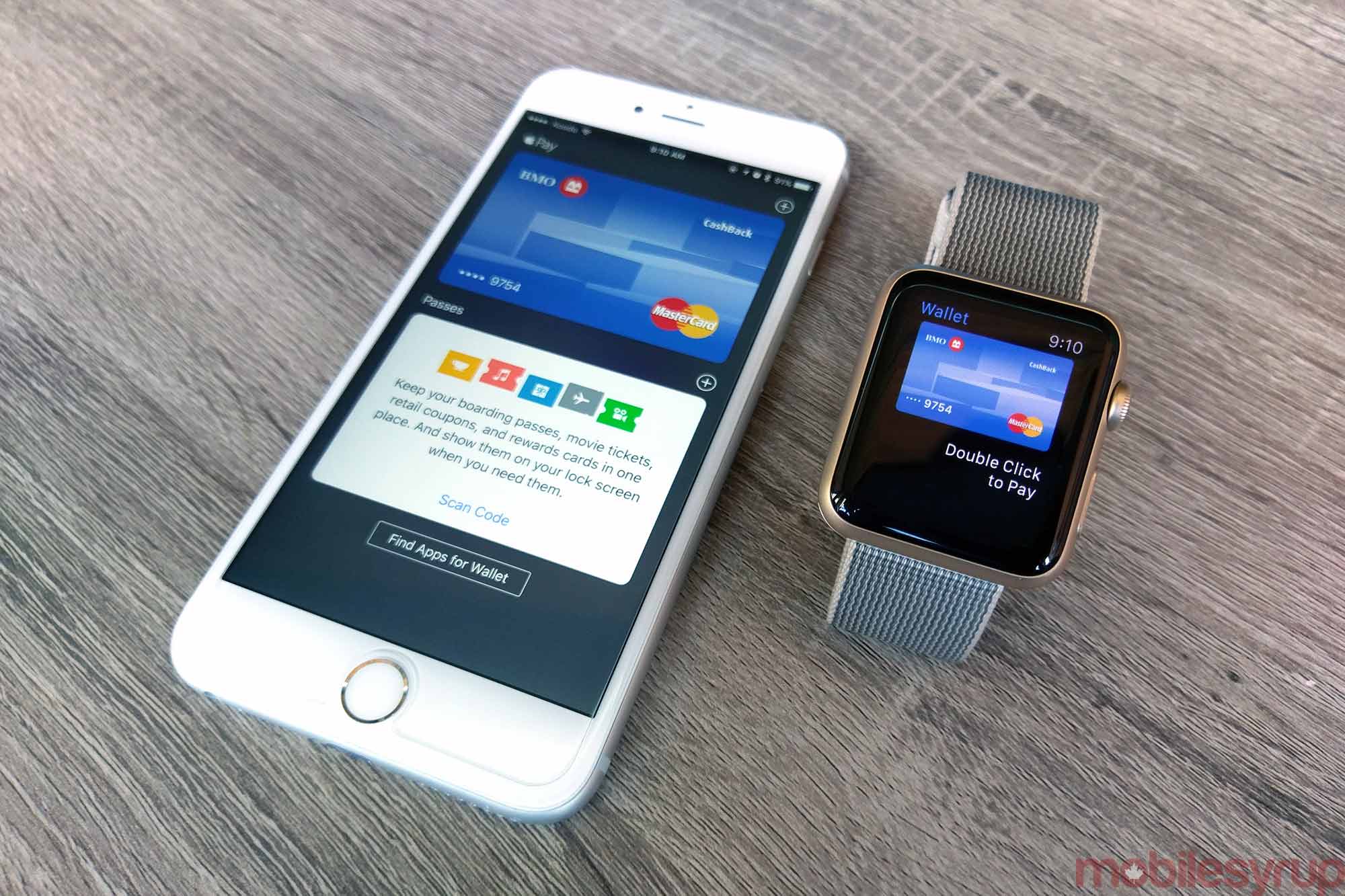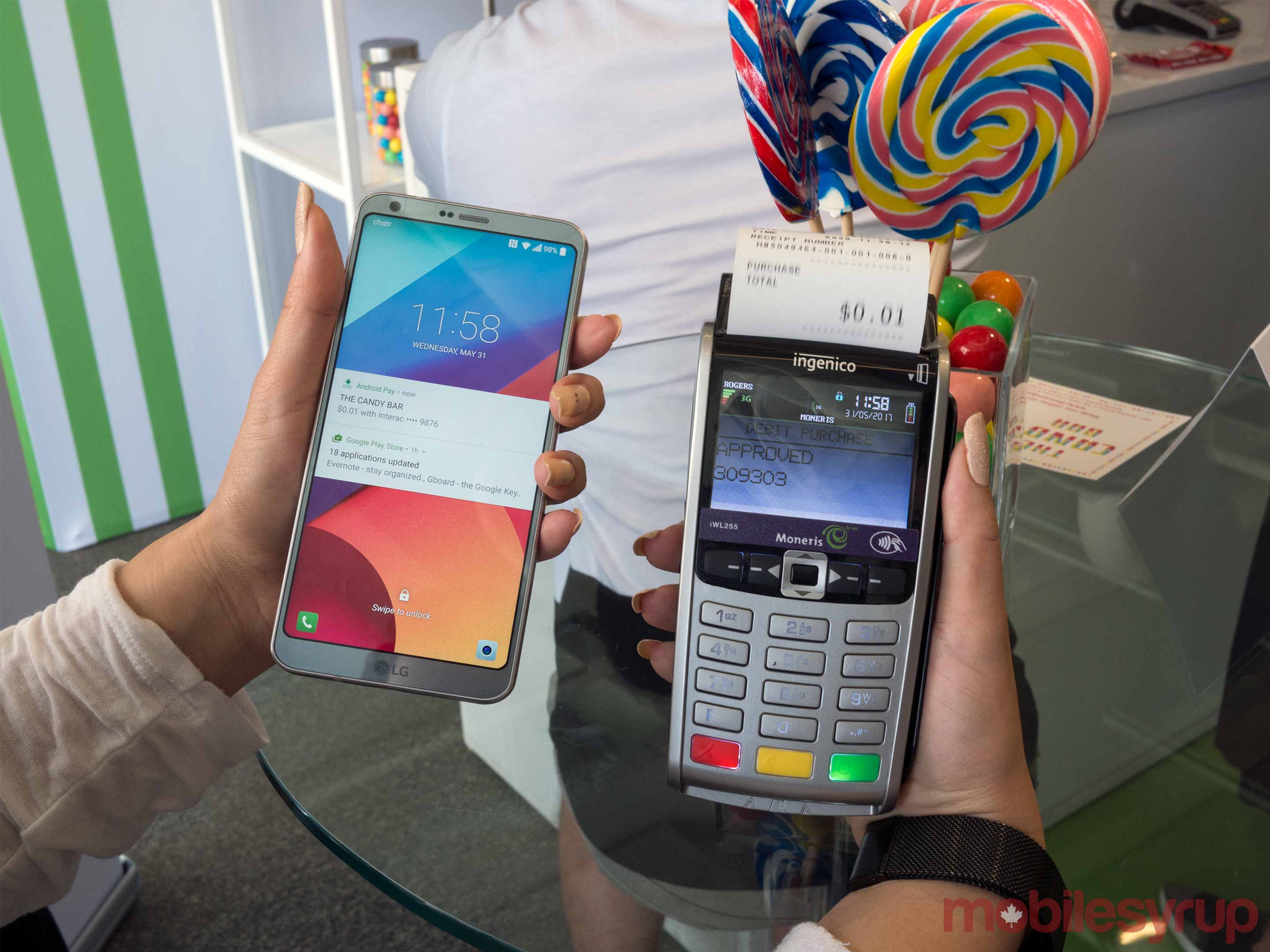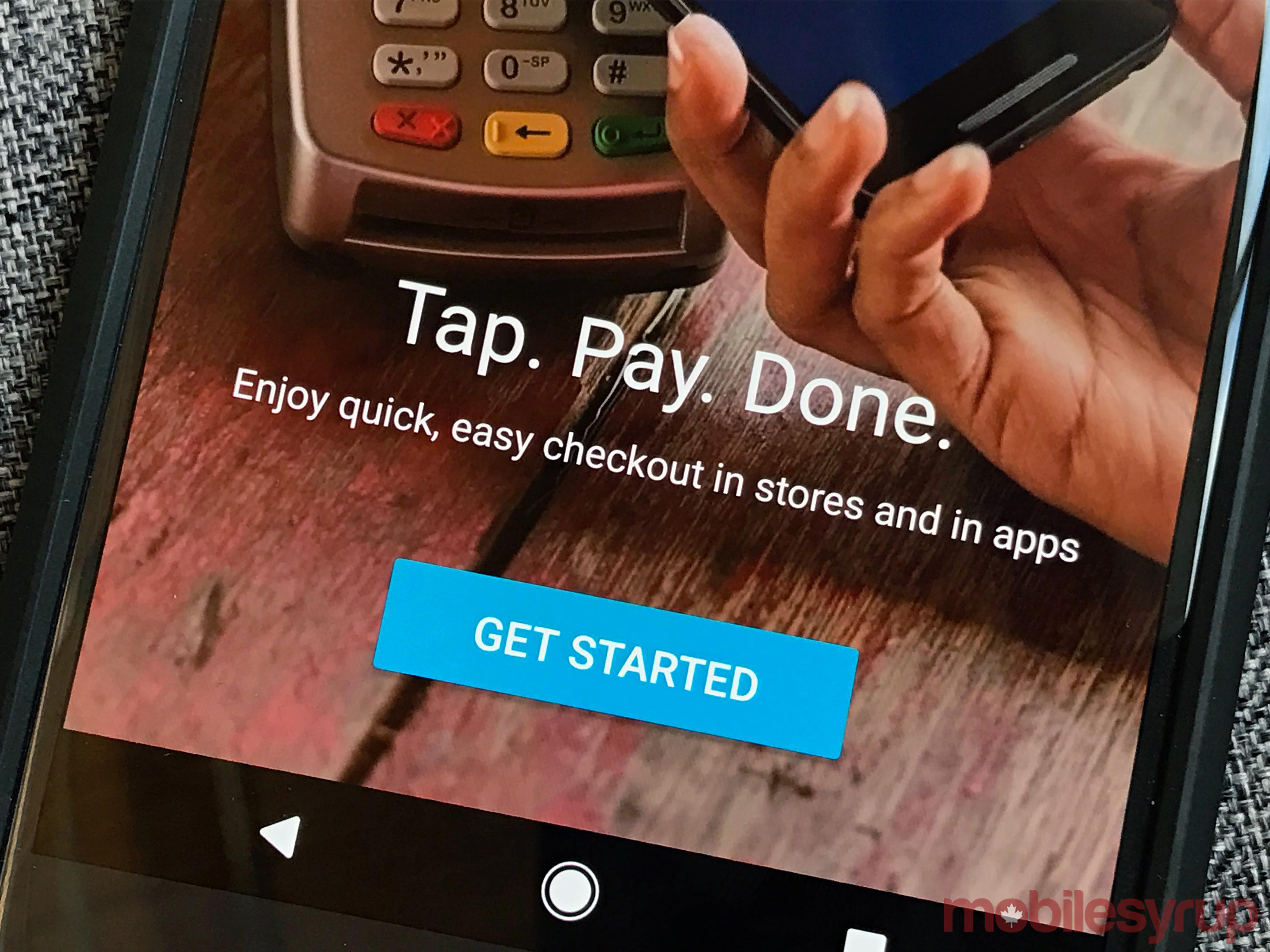
After a seemingly endless wait, Canadian Android users finally have access to Android Pay, about a year after Apple brought its iPhone mobile payments platform to Canada with Apple Pay, and seven months after Samsung Pay soft-launched its service in partnership with CIBC.
With mobile payments now fully available on both major mobile operating systems, the last piece has seemingly fallen into place for Canada’s mobile payments ecosystem. But are Canadians really ready to adopt this new way of paying? MobileSyrup spoke with several experts on the current state of mobile payments in Canada today and projections for the future.
What is Android Pay?
For those less familiar with the concept of Android Pay and mobile payments in specific, Android Pay uses Near Field Communication (NFC) — a technology that’s built-in to the majority of modern smartphones and allows two devices within 4 cm of each other to communicate — to pass a ‘token’ that represents (but does not reveal) a customer’s actual credit or debit card number from their phone to the merchant’s payments machine.
From a software perspective, all the user needs is a phone that’s running a non-developer version of Android 4.4 or above. With those prerequisites, the user can then simply download the Android Pay app to get started. For a more in-depth tutorial, check out our how-to here.
The platform arrived in Canada on May 31st, 2017 — almost two years after it first launched in the U.S. during Google’s 2015 I/O developer conference. As of launch, it supports credit cards from BMO, CIBC, Banque Nationale, Scotiabank, Desjardins, President’s Choice Financial, ATB Financial and Canadian Tire Financial Services.
American Express cards and Tangerine are also coming soon, according to Google (though Tangerine offered a less certain sentiment), and select Interac debit cards will also go live on the platform starting June 5th.
Unlike Apple Pay, which confirmed all five major banks at launch, that list of banks notably leaves out two heavy-hitting Canadian banks — the Royal Bank of Canada and TD Canada Trust.
RBC and TD push back
RBC and TD have opted out of Android Pay for now, both have kept the door open to joining Android Pay in the future — evidently a good PR move, since both have been receiving a high rate of requests that they support the platform on social media from customers.
The banks’ respective statements give a good indication of why Android Pay is off the table for the time being, with both referring customers to use their own Android mobile payments apps — an issue that didn’t affect Apple because the company doesn’t allow third parties to access NFC capabilities, which disallows banks from creating their own digital wallet solutions for that platform.
Robert Smythe, financial insights associate at the IDC Canada research firm, suggested to MobileSyrup that if Google offered more value to banks in the form of data and ownership, both parties would benefit.
“With more value for both their customers and themselves, the banks would be more willing to promote [Android Pay],” said Smythe.
Promotion, he noted, has been sorely lacking for mobile payments so far in the technology’s Canadian history.
“With more value for both their customers and themselves, the banks would be more willing to promote [Android Pay],” said Smythe.
Jason Davies, vice-president of digital payments at Mastercard also suggested the lag was due to the banks hanging on to their own technology.
“I think eventually perhaps they will but it’s one of those things where they obviously have a very, very good digital strategy and they’ll engage with Android Pay when it’s best for their organization and their customers,” said Davies.
Jeff Guthrie, chief sales officer at Moneris, a dominant supplier of payment terminals to merchants across Canada, disagreed on the banks’ motives for not supporting Android Pay.
“I don’t think it’s a rejection of that technology, it’s just that there’s work to be done to enable the technology within their infrastructure and set up the ability for customers to sign on and configure their cards […] but it will happen,” he said.
Lowered expectations for penetration
Just how much does Android Pay change the mobile payments scene in Canada? Experts are split on the matter, but in general there was slightly less confidence in a quick adoption rate than there was after Apple Pay’s launch — which is counter-intuitive considering a large portion of Canadian mobile owners are Android users.
But Smythe says the portion of Canadian Android users that exist are not as large as the public might think.

“We’re seeing Apple iPhones are in the low 50 percent penetration rate, we’re seeing Android in the high 40 percent penetration rate and the gap of the feature phones is probably in the two to three percent range,” said Smythe.
This is a decrease from studies done last year, and is just one of the reasons that Smythe is much less optimistic about the quick adoption of mobile payments than when we last spoke.
Not as quick an uptake as predicted
“My intuition was wrong,” said Smythe about his prediction that Canada would hit 50 percent penetration by 2019. “It’s going to be into the 2020s before we see that sort of heavy penetration. Unless something dramatically changes — and I think that would have to be Apple providing bank access to NFC capabilities, and the ability of banks to really enhance the capabilities of their mobile wallets to really entice people to use mobile payments.”
Smythe bases his opinions on insights published in IDC Canada’s Consumer Survey of Digital Banking Expectations and Experiences — Payments, published in May 2017.
While tap has become more prevalent — Moneris says 38 percent of its three billion transactions last quarter were contactless — the survey revealed that 55 percent of Canadians think the use of pin and card is perfectly convenient, or at least not inconvenient.
Only 22 percent of respondents said they would use any form of mobile payment — Apple, Android or Samsung Pay.
“That doesn’t make mobile payments and tap payments that much more interesting to the consumer,” says Smythe.
Meanwhile, only 22 percent of respondents said they would use any form of mobile payment — Apple, Android or Samsung Pay. In terms of actual usage, IDC found that only one percent of survey participants used Apple Pay daily and two percent weekly, across all age segments. Only in the 25 to 29 age range did that spoke to five percent weekly.
Smythe says part of the disinterest in mobile payments seems linked to the lack of loyalty reward programs. According to IDC’s survey, 44 percent of respondents across all ages were more interested in mobile payments if there was a loyalty link and that increased to about 59 percent in the 25 to 29 age range.
Cautious optimism
Gerry Gaetz, president and CEO of Payments Canada was also cautious in his predictions, stating that within a three to five-year time period, the technology will likely become mainstream due to the convergence of a continued drive for convenience from consumers, an improvement in mobile computing power and capabilities and the underlying payments ‘rail’ (technology and network) that Payments Canada is working to build along with Canadian financial institutions and other stakeholders in the industry.
“These [new technologies] often start slower than you would think and then they often pick up with more speed and sometimes at a certain point they move faster than you’d think,” adding that in a recent Payments Pulse Survey done by the association they found only 13 percent of Canadians using mobile wallets, but that the satisfaction rate was quite high at 83 percent.
“I think that’s an indicator. If people are really happy with something then it’s going to pick up and the word’s going to get out.”

Davies of Mastercard is also optimistic about the effects of Android Pay on the Canadian mobile payments scene, though he too cautioned that adoption would take time.
“It’s not going to be a sprint, it’s going to be a marathon,” he said, adding that he believes there will be a “five-year time horizon for adoption.” He predicts the adoption rate for mobile payments will mirror adoption for contactless payment, which took “five years before it became a ubiquitous piece of a person’s payments arsenal.”
Roadblocks to adoption
Canada’s robust tap-to-pay infrastructure makes it in many ways an ideal market for mobile payments. Interac, for instance, tells MobileSyrup that over half a million merchant locations are flash-enabled and Moneris predicts that half of its transactions will be contactless within the year. However, several experts still see some major roadblocks to adoption.
“Some of the things we see from our survey are for example privacy and security, which are really important to Canadians,” though he notes that in the association’s latest Payments Pulse Survey, 48 percent of respondents were willing to give up some aspects of their personal information in order to get the convenience of a mobile payments app.
“The banks have been tracking their spending on credit cards for many years without the consumer seeing any detrimental impact,” said Smythe.
Smythe notes that Canadians trust their banks more than large tech companies like Apple and Google when it comes privacy and security.
“The banks have been tracking their spending on credit cards for many years without the consumer seeing any detrimental impact.”
While Smythe doesn’t think there’s actually a risk that people’s bank accounts will be compromised with any degree of frequency through digital wallets, he notes there’s “a bit of concern there,” which might be assuaged by linking bank wallets and Android Pay more closely.
“I think integration with bank wallets would be an important facet,” says Smythe, adding that, “integration of loyalty is important and making the whole setup and use of mobile payments as easy as tap.”
A case of ‘forming habits’
“I think it’s a case of forming habits and developing new habits,” says Guthrie of Moneris, adding that people are “very much copy cats, we see the person in front of us and think ‘Oh wow, I think I can do that too,’ and so it is one of those things that sort of builds upon itself and that’s what we saw with the conversion from chip to tap and now to mobile.”

While experts espoused less optimism this year than the previous year about quick adoption of mobile payments technology, the overall outlook is still positive for mobile payments platforms.
Though mobile payments may not go mainstream for many years yet, there’s a clear roadmap for the technology in the adoption of contactless technology, and now that a much larger demographic of Canadians than ever before has access to the technology — including the significant group of Android users that are passionate early adopters — usage is only likely to go up from here.
MobileSyrup may earn a commission from purchases made via our links, which helps fund the journalism we provide free on our website. These links do not influence our editorial content. Support us here.


